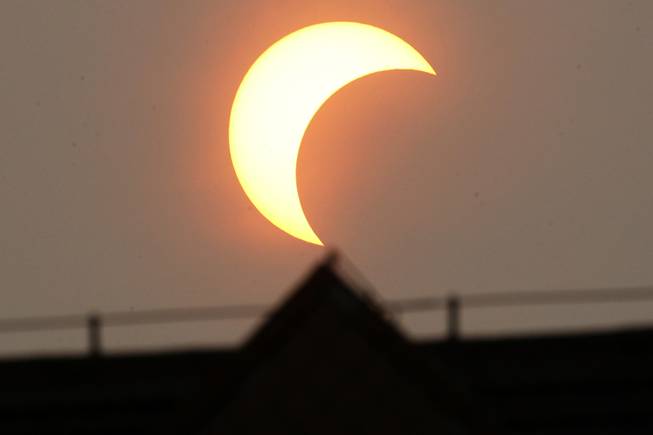
Ng Han Guan / AP
A partial solar eclipse takes place over Beijing, China, Monday, May 21, 2012.
Monday, July 3, 2017 | 2 a.m.
Solar energy efficiency varies with the weather. Utilities are used to that. And in Nevada, cloudy days are few and far between. But what happens to solar energy when Earth is hit by a more disruptive event?
In August, a solar eclipse is expected to interfere with solar power in Nevada and several other big producers. Since 2000, the amount of solar hooked into the grid has increased drastically. As a result, experts predict even a short eclipse will have a significant effect.
In April, the North American Electric Reliability Corp., a nonprofit that monitors grid operations, released a study looking at this issue and areas that could see the most impact.
About the solar eclipse
How to view it
Do NOT use a camera, telescope, or binoculars to look at the sun. Instead, you should use a filter. It’s dangerous for your eyes to stare at the sun, even when it’s in partial eclipse.
NASA recommends purchasing “eclipse glasses.” They are sold by four manufacturers. The space agency also recommends creating a pinhole projection with two pieces of stiff white paper. Use a pin to punch a hole in one sheet, and align it so that the sun shines through the hole and projects an image onto the second sheet. You can watch this projection and see the shadow of the moon crossing the sun.
A solar eclipse occurs when the moon passes between the Earth and the sun, obscuring the sun from view and casting a shadow on the Earth’s surface below. Because the moon is so much closer to us than the sun, it appears bigger (in reality, the sun is as big as 64.3 million moons). The umbra is the darkest part of the moon’s shadow, and where observers will be able to see a total eclipse. The penumbra is the part of the shadow in which observers will see a partial eclipse.
• When: The eclipse will begin at 9:06 a.m. Aug. 21, but its totality will not be viewable in Nevada.
What the eclipse will look like in Nevada
Nevada is not in the path of the moon’s umbra, but we’ll still be able to see a partial eclipse. About 72 percent of the sun will be covered.
• Frequency: Solar eclipses occur every 18 months, but only viewable from part of the planet. How much you can see (or if you can see it at all) depends on where you are on the Earth.
• Other things that happen: Decrease in temperature, confusion among wildlife
COMMON QUESTIONS
What happens to solar energy when there is an eclipse?
As the sun is obscured, the energy generated from photovoltaic solar panels falls. This causes a decrease in the amount of power that contributes to the grid. Utilities have to make up for that drop by getting power elsewhere. When an eclipse hit Europe in 2015, there was a big drop in solar production compared to the amount of solar that would be produced under clear skies.
The eclipse will be visible for about two to three hours, according to NASA. but it’s only going to affect the grid in Nevada for 5 minutes. Why?
Neither the Earth nor the moon is static, which means that during this time, the eclipse will move across the continental United States, from Oregon to South Carolina. As a result, the eclipse will only remain viewable at a particular coordinate for a few minutes.
What happens to the Southwest?
Sunny states like Nevada, Utah and Arizona will experience short gaps as the eclipse moves toward the East on the morning of Aug. 21. Parts of Nevada will experience a full eclipse, according to the NERC report. But NERC concluded that both Nevada and Utah — two Southwestern states generating a larger percentage of solar supply — will have enough alternate resources to meet energy demand during the five-minute window when the eclipse hits the grid.
How is an eclipse different from a cloudy day?
Did you know?
According to Solar Magazine, America’s capacity to generate power by capturing the sun’s rays spiked over the past 10 years, “at a compound growth rate of 59 percent to reach 42 gigawatts” by the end of 2016.
It’s a common misconception that solar panels don’t work on cloudy or rainy days. Solar panels work even when direct sunlight is blocked by clouds. After a heavy rain or snowstorm, solar panels can actually become more efficient because precipitation washes away dirt, according to the Solar Energy Industries Association.
Why can’t utility companies just store solar?
What utilities can do to prepare
• Plan in advance to temporarily disconnect solar panels from the grid.
• Find backup power, if needed, to compensate for the loss of solar power.
• Conduct studies of different scenarios — hot day, cold day — to prepare.
Utility-scale solar farms and most rooftop solar systems lack storage. Companies like Tesla are trying to solve this problem by building storage batteries. But they remain expensive right now, when compared to alternatives like burning natural gas at night.
Do I need to worry about power in MY home?
No. Enjoy watching the eclipse. The utility can compensate for the lack of solar power by firing natural gas plants, which often run during times of peak demand.

Join the Discussion:
Check this out for a full explanation of our conversion to the LiveFyre commenting system and instructions on how to sign up for an account.
Full comments policy